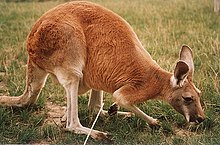| Part of a series on |
| Wildlife of Australia |
|---|
 |

The fauna of Australia consists of a large variety of animals; some 46% of birds, 69% of mammals, 94% of amphibians, and 93% of reptiles that inhabit the continent are endemic to it.[2]: 4 This high level of endemism can be attributed to the continent's long geographic isolation, tectonic stability, and the effects of a unique pattern of climate change on the soil and flora over geological time. A unique feature of Australia's fauna is the relative scarcity of native placental mammals. Consequently, the marsupials – a group of mammals that raise their young in a pouch, including the macropods, possums and dasyuromorphs – occupy many of the ecological niches placental animals occupy elsewhere in the world. Australia is home to two of the five known extant species of monotremes and has numerous venomous species, which include the platypus, spiders, scorpions, octopus, jellyfish, molluscs, stonefish, and stingrays. Uniquely, Australia has more venomous than non-venomous species of snakes.
The settlement of Australia by Indigenous Australians between 48,000 and 70,000 years ago[3][4] and by Europeans from 1788, has significantly affected the fauna. Hunting, the introduction of non-native species, and land-management practices involving the modification or destruction of habitats have led to numerous extinctions.[2]: 8–9 Based on the list of Australian animals extinct in the Holocene, about 33 mammals (27 from the mainland, including the thylacine), 24 birds (three from the mainland), one reptile, and three frog species or subspecies are strongly believed to have become extinct in Australia during the Holocene epoch. These figures exclude dubious taxa like the Roper River scrub robin (Drymodes superciliaris colcloughi) and possibly extinct taxa like the Christmas Island shrew (Crocidura trichura). Unsustainable land use still threatens the survival of many species.[2]: 8–9 To target threats to the survival of its fauna, Australia has passed wide-ranging federal and state legislation and established numerous protected areas.[2]: v
- ^ Egerton, p. 44.
- ^ a b c d Cresswell, Ian; Murphy, Helen T. (2017). State of the Environment 2016: Biodiversity (PDF) (Report). Commonwealth of Australia Department of the Environment and Energy. Archived from the original (PDF) on 26 August 2021. Retrieved 26 August 2021.
- ^ Josephine Flood (2004) Archaeology of the Dreamtime, J.B. Publishing, Marleston p. 283 ISBN 1-876622-50-4
- ^ Rasmussen, M; et al. (2011). "An Aboriginal Australian genome reveals separate human dispersals into Asia". Science. 334 (6052): 94–98. Bibcode:2011Sci...334...94R. doi:10.1126/science.1211177. PMC 3991479. PMID 21940856.